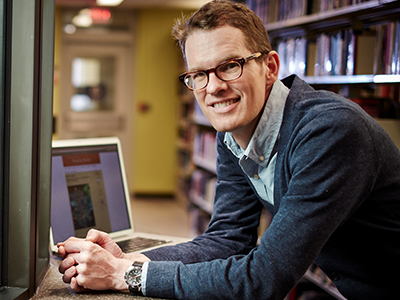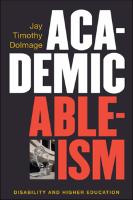Author success story
Context about the author:
Jay Dolmage is a Professor of English Language and Literature at the University of Waterloo. His first book, entitled Disability Rhetoric, was published with Syracuse University Press in 2014. Academic Ableism: Disability and Higher Education was published with University of Michigan Press in 2017, and Disabled Upon Arrival: Eugenics, Immigration, and the Construction of Race and Disability was published in 2018 with Ohio State University Press. He is the Founding Editor of the Canadian Journal of Disability Studies.
Please provide some background information on the research project, book origin, adjacent research, and/or network enabling the book
I grew up in the disability rights movement in Canada – and my entire family is still involved in this movement. I see myself as carrying this fight into higher education, where disability is central to research, but as something to be cured or eradicated; where disability is widely and broadly studied, but where we have a tremendous amount of work to do just to ensure that disabled students get the right to study, to contribute, and to be included.
What was/were your motivation(s) for wanting to publish this book?
Higher education institutions discuss equity, justice, and inclusion a lot. However, they also erect many physical and policy barriers to disabled people. Pointing out the disconnect and identifying practical strategies to improve the situation was the focus of the project. There is a need to understand the ableist history and eugenic foundations of higher education, and to connect these to the ongoing exclusion of disabled students.The goal of the book, however, is not just to describe academic ableism, but to offer tangible tools to reconstruct our institutions. Open access has always connected with the strategies for making learning more accessible that are at the heart of the book.
Please give some information on the funding behind the research / book / network
The book was made open access with support from the Arts Research Office at the University of Waterloo, who also supported the publication of the audiobook version.
Was the book made available on your own website, or the website of any other editors or contributors, or your institution? If so, please state which.
No. It was made available on the publisher’s website and on sites that the publisher sent it to.
Open access success story:
What makes this book successful?
This book identifies the multiple ways in which higher education excludes differently-abled individuals and makes a strong case for practical action. It is written in clear language and advocates strongly for change, but in an evidence-based way that university administrators can trust. Its publication by a university press reassures readers of its quality.
Why did you choose to publish this book open access?
The book needs to reach beyond faculty and student audiences to make change happen. Administrators and education policymakers rely on materials they can easily find and share to advance their thinking. Individuals who are excluded by ableist policies are also an important audience, and it was important not to exclude those without the resources to pay for the book.
Do you think that open access publication helped the book and if so, why?
Yes. The Altmetric data show that the book was shared extensively through social media networks (by the end of 2021 it had potentially reached more than 1,000,000 followers) and people’s ability to share the title and connect other people immediately to the text likely increased their confidence in telling others about the book. In a number of cases, the accounts sharing the text came from organizations that were arranging book club discussions.
Did your OA book show immediate success upon publication, or did the success unfold more slowly over time?
The book has been picked up by a number of reading groups within higher education institutions. These are mentioned in a number of the tweets about the book and seem to have been significant in driving continued usage. Despite being open access, the paperback edition of the book has continued to sell in print at a consistent rate of around 800 a year since publication, except in 2020 when sales were about half that quantity.
If early signs of success started to show, did you try to reinforce this in an unusual or creative way?
The book reinforces presentations and advocacy work. It is always nice to be able to tell a group that the book is available for free, rather than having the (slightly guilty) feeling that to read it they’d have to buy it. The main intervention after the book was published was to get some money to professionally record an audiobook and make it free on Audible.com. We worked with a company called Deyan to find a professional actor, Greg Chung, who recorded the book from his home. The reviews are encouraging and suggest that audio is a pathway to the written word, e.g., “This is a dense book with history, status quo, and suggestions for further improvement. As a university administrator, it gave me much to think about. I plan to reread the section about Universal Design, and explore the recommended further readings.”
Did open access help to reach unreachable / unknown / unexpected / new audiences? If yes, how do you know this?
As reader responses to the U-M Press pop-up survey indicate, the open access edition reached many disabled readers who appreciated that the title was made available as a well-formatted EPUB. For them, it wasn’t just that the book was free to download, but also produced with a strong commitment to accessible publishing.
Did open access make new connections / follow-up possible?
Open access availability probably increased the number of invitations to speak that I received. I have presented at 31 workshops and/or keynotes on the book since the beginning of 2021. These engagements have been diverse: from community colleges to R1 schools, and for academic organizations as distinct as the American Association of Veterinary Medicine Colleges and the American Institute of Chemical Engineers; they have also been international, with presentations in Canada, the US, the UK, Switzerland, etc.
Is there any long tail (awareness, citations, downloads) of this book that you consider would (most likely) not have happened with print sales only or toll-access?
The citations indicate not only that the book is used across many disciplines but also internationally (e.g., in Botswana). This influence across disciplinary boundaries and in countries where the money to buy books is limited feels connected to the open access availability.
How do you think academia can benefit from your book being OA?
The book is particularly designed for university administrators. Even though they have access to library resources, they are not reliant on them in the way faculty and students are. Having the book fully accessible through a quick Google search helped to reach them.
How do you think society at large can benefit from your book being OA?
The reader responses to the U-M Press pop-up survey on Fulcrum, the Amazon reviews, and Goodreads reviews shows that many differently-abled individuals recognized their own experiences in the book. They felt seen and heard, and it gave them an extra resource to express how they experience exclusion in their own work lives.

This article is made available under a Creative Commons Attribution 4.0 International License.


